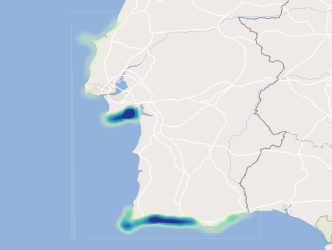Keyword
Espécie
28 record(s)
Type of resources
Available actions
INSPIRE themes
Provided by
Years
Formats
Representation types
Update frequencies
Status
Service types
Scale
geoDescCode
cartografia
geographicCoverage
geographicCoverageDesc
inspirecore
referenceDateRange
denominatorRange
resolutionRange
dataPolicy
openServiceType
dataType
dataFormat
-
Web map service with an aproximate location of the cetacean strandings in mainland Portugal. These prepresent any marine animal that comes ashore or near the shore. Include an event in the wild where a marine mammal is found dead on the beach or shore or floating; when a marine mammal is alive on the beach or shore, but unable to return to the water due to sickness or injury or some other obstacle and when a marine mammal is in the water, but is unable to return to its natural habitat without assistance.
-
Web feature service with an aproximate location of the cetacean strandings in mainland Portugal. These prepresent any marine animal that comes ashore or near the shore. Include an event in the wild where a marine mammal is found dead on the beach or shore or floating; when a marine mammal is alive on the beach or shore, but unable to return to the water due to sickness or injury or some other obstacle and when a marine mammal is in the water, but is unable to return to its natural habitat without assistance.
-

Areas of activity by companies authorized to carry out tourist operations for the observation of cetaceans in the waters of mainland Portugal, as stipulated in Decree-Law no. 9/2006 of 6 January.
-
Web Map Service with observations data of the species Tursiops truncatus under the Action Plan for the Protection and Monitoring of resident population of Bottlenose dolphins from Sado Estuary.
-
Web map service within the framework of the SNIMar project, which consists of the georeferencing of a set of sites on the Coast of Mainland Portugal where seabird and aquatic birds can be observed.
-
Download service from observations data of the species Tursiops truncatus under the Action Plan for the Protection and Monitoring of resident population of Bottlenose dolphins from Sado Estuary.
-
Web feature service within the framework of the SNIMar project, which consists of the georeferencing of a set of sites on the Coast of Mainland Portugal where seabird and aquatic birds can be observed.
-
Localização das árvores classificadas de interesse publico. O Arvoredo de Interesse Público compreende exemplares isolados ou conjuntos arbóreos que, pela sua representatividade, raridade, porte, idade, historial, significado cultural ou enquadramento paisagístico, possam ser considerados de relevante interesse público e se recomenda a sua cuidadosa conservação. A classificação de "Interesse Público" atribui ao arvoredo um estatuto similar ao do património edificado que se encontra classificado.
-
Localização das árvores classificadas de interesse publico. O Arvoredo de Interesse Público compreende exemplares isolados ou conjuntos arbóreos que, pela sua representatividade, raridade, porte, idade, historial, significado cultural ou enquadramento paisagístico, possam ser considerados de relevante interesse público e se recomenda a sua cuidadosa conservação. A classificação de "Interesse Público" atribui ao arvoredo um estatuto similar ao do património edificado que se encontra classificado.
-
Departure places of vessels owned by companies authorized to carry out tourist operations for the observation of cetaceans in the waters of mainland Portugal, as stipulated in Decree-Law no. 9/2006 of 6 January.
